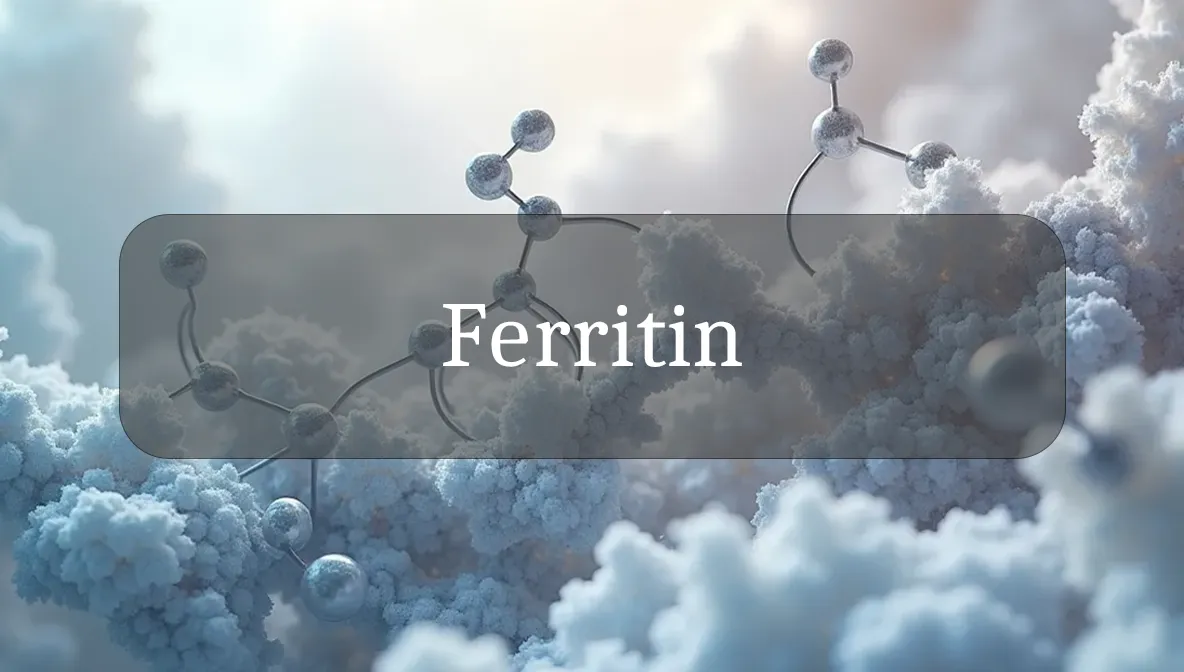Iron Storage Protein for Energy and Vitality
Ferritin might sound like a technical term, but it’s a vital protein in your body that acts like a savings account for iron, keeping your energy levels up and your cells thriving. As a key player in iron metabolism, ferritin is essential for daily wellness, especially for those focused on maintaining stamina and overall health. Let’s dive into what ferritin is, why it matters, and how to keep it balanced for a healthier you, all in a friendly, easy-to-understand way.
Identity and Type
Ferritin is a protein that stores iron, a tiny nutrient your body needs for oxygen transport and energy. It’s not an essential amino acid or nutrient itself but a structural protein found in nearly every cell, especially in the liver, spleen, and bone marrow. Think of ferritin as a storage vault that safely holds iron until your body needs it, releasing it to keep your blood cells and muscles powered up.
Biological Role and Health Benefits
Ferritin is like the gatekeeper of your body’s iron supply, supporting several crucial functions:
- Iron Storage and Release: Ferritin stores iron in a safe, non-toxic form, releasing it when needed to make red blood cells, which carry oxygen to your tissues for energy and vitality.
- Energy and Stamina: By ensuring a steady iron supply, ferritin helps prevent fatigue, keeping you active and alert.
- Immune Support: Ferritin provides iron for immune cells to fight infections, boosting your body’s defenses.
- Hair and Skin Health: Adequate iron from ferritin supports healthy hair growth and glowing skin by fueling oxygen delivery to tissues.
- Protection Against Iron Overload: Ferritin prevents excess iron from damaging cells by storing it safely, acting like a cell protector.
By managing iron, ferritin supports energy, immunity, and overall wellness.
Dietary Sources and Supplements
Ferritin isn’t consumed directly, but its levels depend on your iron intake from foods or supplements:
- Dietary Sources:
- Heme Iron (easily absorbed): Red meat, poultry (like chicken liver), and fish (like salmon or tuna).
- Non-Heme Iron (less absorbed): Leafy greens (spinach, kale), legumes (lentils, chickpeas), fortified cereals, and nuts (like pumpkin seeds).
- Iron Boosters: Vitamin C-rich foods (oranges, bell peppers) enhance non-heme iron absorption when eaten together.
- Supplements:
- Iron supplements (like ferrous sulfate or ferrous gluconate) can boost ferritin levels if prescribed for low iron or anemia.
- Multivitamins with iron may support ferritin in those with low dietary intake.
- Factors Affecting Ferritin: Absorption varies based on gut health, dietary inhibitors (like tea, coffee, or calcium), or conditions like pregnancy or heavy menstruation, which increase iron needs.
A balanced diet with iron-rich foods supports healthy ferritin levels.
Signs of Imbalance
Ferritin levels reflect your iron stores, and imbalances can signal health issues:
- Low Ferritin (Iron Deficiency):
- Symptoms: Fatigue, weakness, pale skin, brittle nails, hair loss, shortness of breath, or restless legs.
- Causes: Low iron intake, heavy periods, pregnancy, blood loss (e.g., ulcers), or malabsorption (e.g., celiac disease).
- Impact: Can lead to iron-deficiency anemia, reducing oxygen delivery and energy.
- High Ferritin (Iron Overload):
- Symptoms: Joint pain, fatigue, abdominal pain, skin darkening, or heart palpitations.
- Causes: Hemochromatosis (genetic iron overload), excessive iron supplements, frequent blood transfusions, or liver disease.
- Impact: Excess iron can damage organs like the liver, heart, or pancreas.
If you notice symptoms like extreme tiredness or joint pain, see a doctor to check ferritin levels with a blood test.
Supporting Optimal Levels or Function
Keeping ferritin levels balanced is key to energy and health. Here are practical tips:
- Eat Iron-Rich Foods: Include 1–2 servings daily of iron-rich foods like lean beef, spinach, or fortified cereal. Pair non-heme iron sources with vitamin C (e.g., spinach salad with tomatoes) for better absorption.
- Supplement Wisely: Only take iron supplements if prescribed, as excess can raise ferritin too high. Typical doses for deficiency are 60–120 mg daily, split to reduce stomach upset.
- Limit Iron Blockers: Avoid tea, coffee, or high-calcium foods (like milk) with iron-rich meals, as they reduce absorption. Wait 1–2 hours between these.
- Support Gut Health: A healthy gut absorbs iron better. Eat fiber-rich foods (fruits, veggies) and consider probiotics if you have digestive issues.
- Monitor Regularly: If you’re at risk (e.g., vegetarian, pregnant, or have heavy periods), get ferritin tested yearly to catch imbalances early.
Routine blood tests can track ferritin, especially if you have fatigue or risk factors for imbalance.
Safety, Interactions, and Precautions
Ferritin itself is safe as a natural protein, but managing iron intake to maintain healthy ferritin levels requires caution:
- Safety: Dietary iron is safe for most. Excessive supplements can lead to high ferritin, risking organ damage, while low intake depletes ferritin, causing anemia.
- Interactions: Iron supplements can reduce absorption of medications like antibiotics (e.g., tetracyclines) or thyroid drugs. Take iron 2 hours apart from these. Calcium or zinc supplements may also block iron absorption.
- Precautions:
- People with hemochromatosis, liver disease, or thalassemia should avoid iron supplements and monitor ferritin closely.
- Avoid high-dose iron supplements (over 45 mg daily) unless prescribed, as they can cause nausea, constipation, or toxicity.
- Children are at risk of iron poisoning from supplements; keep them out of reach.
- Storage: Store iron supplements in a cool, dry place, securely away from children.
Fun Fact
Did you know ferritin is like a tiny magnet in your body? Each ferritin molecule can hold up to 4,500 iron atoms, acting like a super-efficient storage unit that keeps your iron organized and ready for action!
Citations
- National Institutes of Health (NIH). (2023). Iron: Fact Sheet for Health Professionals.
- Mayo Clinic. (2024). Iron Deficiency Anemia: Symptoms and Causes.
- Cleveland Clinic. (2023). Ferritin Blood Test.
- World Health Organization (WHO). (2022). Iron Deficiency Anemia Guidelines.
- USDA National Nutrient Database. (2023). Iron Content in Foods.

